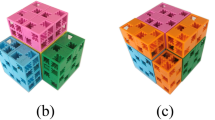Abstract
In this paper we describe an ontological and semiotic model for mathematical knowledge, using elementary combinatorics as an example. We then apply this model to analyze the solving process of some combinatorial problems by students with high mathematical training, and show its utility in providing a semiotic explanation for the difficulty of combinatorial reasoning. We finally analyze the implications of the theoretical model and type of analysis presented for mathematics education research and practice.
Similar content being viewed by others
References
Anderson, M., Sáenz-Ludlow, A., Zellweger, S. and Cifarelli, V.V. (eds.): 2003, Educational Perspectives on Mathematics as Semiosis: From Thinking to Interpreting to Knowing, LEGAS, Otawa.
Batanero, C., Godino, J.D. and Navarro-Pelayo, V.: 1994, Razonamiento Combinatorio (Cominatorial Reasoning), Síntesis, Madrid.
Blumer, H.: 1982, El Interaccionismo Simbólico: Perspectiva y Método (Symbolic Interactionism: Perspective and Method), Hora, Barcelona (Original work published in 1969).
Brown, J.R.: 1998, ‘What is a definition?’, Foundations of Science 1, 111–132.
Brousseau, B.: 1997, Theory of Didactical Situations in Mathematics, Kluwer A.P., Dordrecht.
Cassirer, E.: 1971, Filosofía de las Formas Simbólicas (Philosophy of Symbolic Forms), Fondo de Cultural Económica, México (Original work published in 1964).
Cobb, P. and Bauersfeld, H. (eds.): 1995, The emergence of Mathematical Meaning: Interaction in Classroom Cultures, Erlbaum, Hillsdale, NY.
Cobb, P., Yackel and McClain, K. (eds.): 2000, Symbolizing and Communications in Mathematics Classrooms, Erlbaum, London.
Dubois, J.D.: 1984, ‘Une systematique des configurations combinatoires simples’, Educational Studies in Mathematics 15, 37–57.
Duval, R.: 1993, ‘Registres de représentation sémiotique et functionnement cognitive de la pensée’ (Register of semiotic representation and cognitive functioning of thought). Annales de Didactique et de Sciences Cognitives 5, 37–65.
Eco, U.: 1979, Tratado de Semiótica General, Lumen, Barcelona.
Ellerton, N.F. and Clarkson, P.C.: 1996, ‘Language factors in mathematics teaching and learning’, in Bishop, A.J. et al. (eds.), International Handbook of Mathematics Education, Kluwer, Dordrecht, pp. 987–1034.
Ernest, P.: 1993, ‘Mathematical activity and rethoric: A social constructivist account’, in Hirabasash, I., Nohda, N., Shigematsu, K., and Lin, F. (eds.), Proceedings of the Seventeenth Conference of the International Group for the Psychology of Mathematics Education, Vol. II, University of Tsukuba, Japan, pp. 238–245.
Ernest, P.: 1997, ‘Introduction: Semiotics, mathematics and mathematics education’, Philosophy of Mathematics Education Journal 10; URL: http://www.ex.ac.uk/ PErnest/pome10/art1.htm
Ernest, P.: 1998, Social Constructivism as a Philosophy of Mathematics, SUNY Press, Albany, NY.
Goldin, G.: 1998, ‘Representations and the psychology of mathematics education: Part II’, Journal of Mathematical Behaviour 17(2), 135–165.
Godino, J.D.: 2002, ‘Un enfoque ontológico y semiótico de la cognición matemática’, Recherches en Didactiques des Mathématiques 22(2/3), 237–284.
Godino, J.D.: 1996. ‘Mathematical concepts, their meaning, and understanding,’ in Puig, L., and Gutiérrez, A. (eds.), Proceedings of the Twentieth Conference of the International Group for the Psychology of Mathematics Education, Vol. II, University of Valencia, Valencia, Spain, pp. 417–424.
Godino, J.D. and Batanero, C.: 1994, ‘Significado institucional y personal de los objetos matemáticos' (Institutional and personal meaning of mathematical objects), Recherches en Didactique des Mathématiques 14(3), 325–355.
Godino, J.D. and Batanero, C.: 1998, ‘Clarifying the meaning of mathematical objects as a priority area of research in mathematics education’, in Sierpinska, A., and Kilpatrick, J. (eds.), Mathematics Education as a Research Domain: A Search for Identity, Kluwer, Dordrecht, pp. 177–195.
Godino, J.D. and Batanero, C.: 1999, ‘The meanings of mathematical objects as analysis units for didactic of mathematics’, in Schwank, I. (ed.), European Research in Mathematics Education III, CERME 1, Forschungsinstitut für Mathematikdidaktik, Osnabrück, pp. 236–248.
Grimaldi, R.: 1989, Discrete and Combinatorial Mathematics: An Applied Introduction, Addison-Wesley, Reading, MA.
Hjemslev, L.: 1971, Prolegómenos a una Teoría del Lenguaje (Preface to a theory of language), Gredos, Madrid (Original work published in 1943).
Pimm, D.: 1995, Symbols and Meanings in School Mathematics, Routledge, London.
Roa, R.: 2000, Razonamiento Combinatorio en Estudiantes con Preparación Matemática Avanzada (Combinatorial Reasoning in Students with Advanced Mathematical Training), Unpublished Ph.D. Dissertation, University of Granada, Spain.
Sierpinska, A.: 1994, Understanding in Mathematics, The Falmer Press, London.
Ullman, S.: 1962, Semántica. Introducción a la Ciencia del Significado, Aguilar, Madrid, 1978.
Vergnaud, G.: 1990, ‘La théorie des champs conceptuels’, Recherches en Didactiques des Mathématiques 10 (2/3), 133–170.
Vile, A. and Lerman, S.: 1996, ‘Semiotics as a descriptive framework in mathematics domain’, in Puig, L., and Gutierrez, A. (eds.), Proceedings of the Twentieth Conference of the International Group for the Psychology of Mathematics Education, Vol. IV, University of Valencia, Valencia, pp. 395–402.
Vygotsky, L.S.: 1993, Pensamiento y lenguaje (Obras escogidas II, pp. 9–287), Visor, Madrid (Original work published in 1934).
Author information
Authors and Affiliations
Corresponding author
Rights and permissions
About this article
Cite this article
Godino, J.D., Batanero, C. & Roa, R. An Onto-Semiotic Analysis of Combinatorial Problems and the Solving Processes by University Students. Educ Stud Math 60, 3–36 (2005). https://doi.org/10.1007/s10649-005-5893-3
Issue Date:
DOI: https://doi.org/10.1007/s10649-005-5893-3




